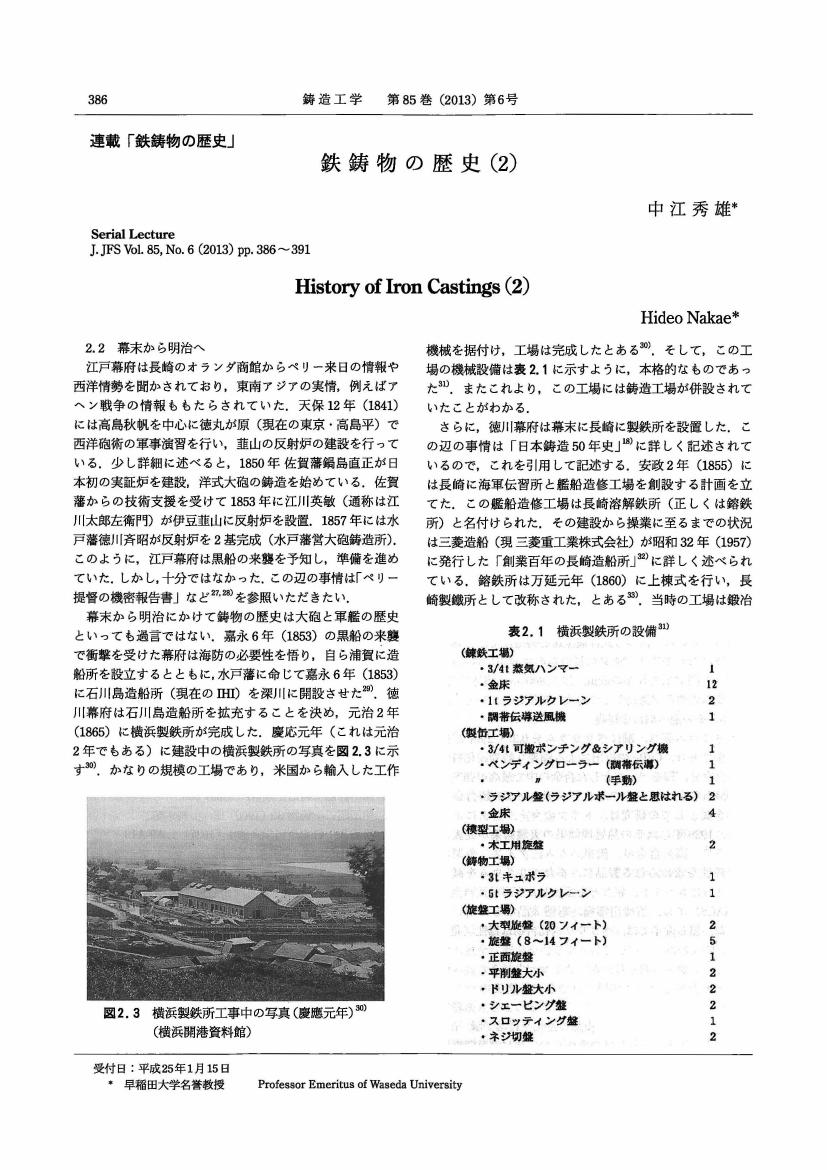5 0 0 0 OA 明治時代の鋳鉄鋳物
- 著者
- 中江 秀雄
- 出版者
- 公益社団法人 日本鋳造工学会
- 雑誌
- 鋳造工学 全国講演大会講演概要集 第166回全国講演大会講演概要集 (ISSN:18805388)
- 巻号頁・発行日
- pp.3-4, 2015 (Released:2017-02-01)
- 参考文献数
- 4
4 0 0 0 OA 江戸時代後期に製作された火縄銃の特異組織と製法
- 著者
- 久保田 俊輔 峯田 元治 安井 純一 中江 秀雄
- 出版者
- 一般社団法人 日本鉄鋼協会
- 雑誌
- 鉄と鋼 (ISSN:00211575)
- 巻号頁・発行日
- vol.97, no.11, pp.566-571, 2011-11-01 (Released:2011-11-01)
- 参考文献数
- 19
The metallurgical macro- and micro-structure, and the residualstress of the Japanese matchlock gun, fabricated at the late Edo period, have been investigated with an optical microscope, an SEM, an EPMA and an X-ray residual stress meter for estimating the fabricating process and their materials. This gun was fabricated by Udonbari (in Japanese) process, which is similar to that of the Russell's method, tubes was created by the joining together opposite edges of a flat iron strip with an iron core bar. The joining line was wavy. Their residual stress was mainly compressive and the values were from 180 to 280 MPa in the longitudinal direction and from 240 to 380 MPa at the transverse direction.The gun was made of low carbon steel with equiaxed ferrite grains; their grain size was mainly 10 μm partly with 100 μm and exceptionally more than 1000 μm grains. Moreover, we find the special banded structure, consisted of fine ferrite grains bands and large ferrite grains bands.The firing part was fabricated by the joining of five parts for getting the L-shape hole. The female screw was made by forging; therefore the shape was tapered screw and the male screw was cut from a low grade steel bar, confirmed by their macro-structure.
2 0 0 0 OA 鋳鉄鋳物の歴史
- 著者
- 中江 秀雄
- 出版者
- 公益社団法人 日本鋳造工学会
- 雑誌
- 鋳造工学 (ISSN:13420429)
- 巻号頁・発行日
- vol.85, no.4, pp.238-242, 2013-04-25 (Released:2018-01-01)
- 参考文献数
- 24
- 被引用文献数
- 1
1 0 0 0 OA わが国の鉄製大砲の科学的考察
- 著者
- 中江 秀雄
- 出版者
- 一般社団法人 日本塑性加工学会
- 雑誌
- ぷらすとす (ISSN:24338826)
- 巻号頁・発行日
- vol.2, no.17, pp.290-295, 2019 (Released:2019-06-22)
- 参考文献数
- 29
1 0 0 0 OA 鉄鋳物の歴史 (3)
- 著者
- 中江 秀雄
- 出版者
- 公益社団法人 日本鋳造工学会
- 雑誌
- 鋳造工学 (ISSN:13420429)
- 巻号頁・発行日
- vol.85, no.7, pp.452-462, 2013-07-25 (Released:2018-01-01)
- 参考文献数
- 40
1 0 0 0 OA 鉄鋳物の歴史 (2)
- 著者
- 中江 秀雄
- 出版者
- 公益社団法人 日本鋳造工学会
- 雑誌
- 鋳造工学 (ISSN:13420429)
- 巻号頁・発行日
- vol.85, no.6, pp.386-391, 2013-06-25 (Released:2018-01-01)
- 参考文献数
- 22
1 0 0 0 OA 鉄鋳物の歴史 (4)
- 著者
- 中江 秀雄
- 出版者
- 公益社団法人 日本鋳造工学会
- 雑誌
- 鋳造工学 (ISSN:13420429)
- 巻号頁・発行日
- vol.85, no.8, pp.534-541, 2013-08-25 (Released:2018-01-01)
- 参考文献数
- 14





